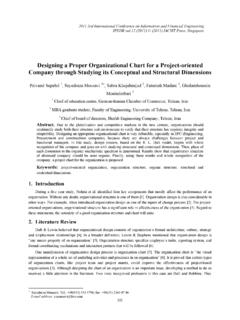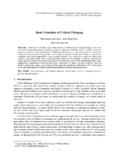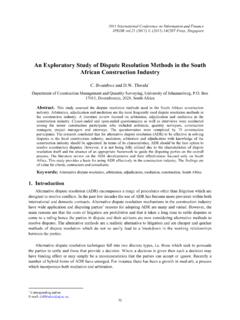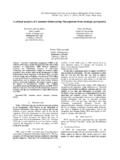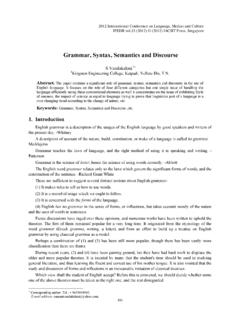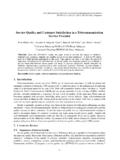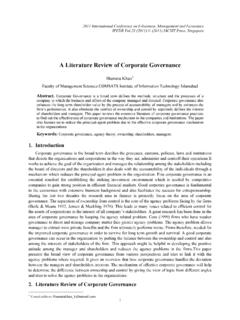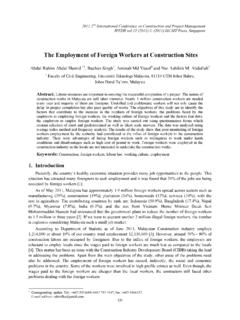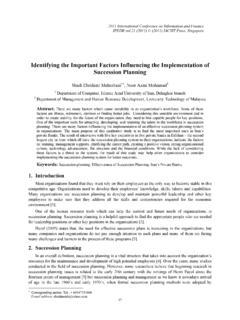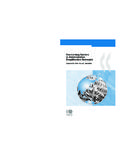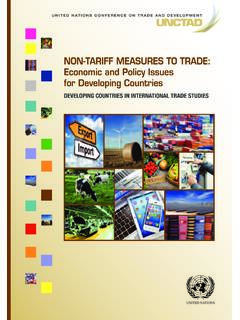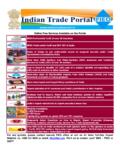Transcription of The Determinants of Non-Tariff Barriers in …
1 The Determinants of Non-Tariff Barriers in malaysia s manufacturing Sector Azlina Hanif Department of Economics, Faculty of Business Management Universiti Teknologi MARA Shah Alam, Selangor, malaysia E-mail: Rokiah Alavi, Gairuzazmi Mat Ghani, and Jarita Duasa Department of Economics, Kuliyyah of Economics and Management Sciences International Islamic University malaysia Gombak, Selangor, malaysia E-mail: successive rounds of multilateral trade negotiations have resulted in significant tariff reductions in many countries. malaysia is no exception as its trade weighted average tariff rate in 2008 is relatively low at percent. Despite the reduction in tariff barrier, the incidence of Non-Tariff Barriers (NTBs) in the country s manufacturing sector is still prevalent especially in certain sub-sectors even though efforts at dismantling these Barriers have long been initiated. Thus, the paper seeks to identify factors that influence the level of NTBs in the manufacturing sector.
2 Using the autoregressive distributed lag (ARDL) approach to cointegration, we find sectoral competitiveness level to be the only significant determinant of NTBs in the long run. In the short run, tariff and sectoral competitiveness both influence the level of NTBs. The findings provide a greater understanding of the reasons behind trade protectionism in the country s manufacturing sector. Keywords: Non-Tariff Barriers ; manufacturing sector; trade protectionism; developing country 1. INTRODUCTION The successive General Agreement on tariffs and Trade (GATT) rounds of multilateral trade negotiations have generally lowered the tariff rates faced by both the developed and developing countries. With this low tariff environment, the role of Non-Tariff barriers1, henceforth NTBs, as a protectionist and regulatory trade policy instrument will become prevalent. Several studies have found that many countries have in fact increasingly used NTBs.
3 For example, the average number of tariff lines per country affected by any type of NTB in 1994 was approximately 1,880 but in 2004, this has increased to 5,620 [1]. More recently, between March and June 2009 itself, 119 new trade-related measures were notified to the World Trade Organization (WTO), causing the measures for trade restricting and distorting policies to surpass the measures for trade liberalization by a factor of 2 [2]. Despite being recognized as one of the remarkably open economies in the world with a merchandise trade to GDP ratio of 2 in 2005 [3], malaysia is found to have relatively high Ad Valorem Equivalent of core NTBs [4]. Core NTBs, such as price and quantity control measures, technical regulations, and monopolistic 1 Hillman (as cited in [8]: 132), defines NTBs as restrictions other than the traditional customs duties that represent distortions to international trade.
4 Specifically, they are any measures other than tariff that hampers the importation of goods directly into a country and are considered discriminatory, as they do not apply equally to domestic production or distribution. 9 2011 International Conference on Economics and Business Information IPEDR (2011) (2011) IACSIT Press, Bangkok, Thailand measures are typically imposed specifically to restrict imports. Being a developing country, it may be possible for NTBs to be imposed for various protectionist and non-protectionist reasons. Various Non-Tariff measures (NTMs) which could be trade inhibiting are indeed prevalent in malaysia . One of these measures is the non-automatic import-licensing requirement. These non-automatic licenses mostly affect the country s non-agricultural imports [5]. Among the imports are those from the automotive, telecommunications, organic chemicals, iron and steel as well as the machinery and mechanical appliances categories.
5 Moreover, malaysia is one of a few Asia Pacific countries that are still using non-automatic licenses to control import even though substantial trade policy reforms have been carried out [6]. This licensing system may in itself impede trade as the administrative processes involved in determining license recipients would easily distort market access opportunities. In fact, [6] found that in 2001, malaysia was the sole country in the region whose number of tariff lines imposed with non-automatic licenses increased from 17 percent to 27 percent after the Asian Financial Crisis. [7] attributes this increase to the need to reduce the country s current account deficit or to protect local industries. The presence of NTMs or NTBs as a policy instrument could pose a hindrance to freer flow of trade between malaysia and her trading partners. This could effectively deny the country from realizing the true gains from free trade.
6 Not only do NTBs become the main obstacles to international trade and investments, they also lead to a greater welfare loss and terms-of-trade deterioration effect compared to tariffs [9]. NTBs also increase the operating costs of firms and hamper firms access to markets. Thus, given that malaysia is an open economy but the presence of NTMs or NTBs are still prevalent, the purpose of the present study is to determine the factors that influence the level of NTBs in the country s manufacturing sector. As the country depends on manufacturing exports to generate economic growth, it is feared that the imposition of NTBs on imports may adversely affect the country s manufacturing exports sector due to the rise in the production costs as a result of higher import prices. The paper is organized as follows. The next section briefly describes the various NTMs and NTBs that are imposed on the country s manufacturing imports.
7 The subsequent section elaborates on the theoretical model for the Determinants of NTBs. This is followed by the empirical analysis and findings from the study. The last section concludes the study. 2. NTBS IN THE manufacturing SECTOR NTMs were introduced for manufacturing products in the early stage of industrialization period to support the first phase of import substitution (IS1) policy. These measures were imposed mainly to protect domestic producers and to allow newly established domestic industries to grow. The level of protection was not high as the objective of IS1 was to supply the domestic market [10]. The second round of import-substitution period, IS2, was launched in the early 1980s. The aim of IS2 policy was to develop indigenous heavy manufacturing industries that generate linkages with the rest of the domestic economy and to correct the country s trade balance. Iron and steel, automotive and cement industries became the focus to develop local technology.
8 According to [10], high protection levels in the form of tariffs and quotas characterized the period. As mentioned in the preceding section, a large proportion of non-agricultural NTMs in malaysia are in the form of non-automatic licenses [5], which raised the concern that they are imposed for protectionist purposes. Among the manufacturing imports that are subject to these licenses are heavy and construction equipments, iron and steel products, industrial chemicals, and electrical household equipments [11]. Nevertheless, NTMs in malaysia s manufacturing sector did not seem to significantly affect exporters from the According to [12], the measures seemed to apply to a relatively small number of sectors and products. Furthermore, measures such as import license, technical license, standards and labeling requirements were implemented fairly. Recent reports however suggest that the country s import regulation measures are non-transparent and ambiguous [13].
9 The details of imports imposed with at least one type of NTMs are listed in the country s Royal Malaysian Customs Customs (Prohibition of Import) Order [14]. There are four schedules that classify imports based on 10the purpose of the NTMs. We focus only on manufacturing imports2 listed in the second to fourth schedules as the first schedule lists goods whose imports are totally prohibited. The second schedule lists imports that are allowed only with import licenses for protection of health, sanitary, security, environmental, and intellectual property. The third schedule records imports imposed with licenses to protect local industries while the fourth schedule records goods whose imports are only allowed according to the manner of importation specified. In the second schedule, coins and disc-operated amusement machines, diamonds and diamond set jewellery, explosives, fireworks, several types of communication apparatus, safety headgear, mosquito coils, various types of motor vehicles and their parts, several types of machinery, iron and steel sheets, and arms and ammunitions other than those imported by bona fide travellers were imposed with import licensing requirement in 1978.
10 In the 1980s, several product reviews were made resulting in more products being included in the schedule. These are those from the electrical machinery and telecommunications equipment group, boilers, machinery and mechanical appliances group and organic chemical group. Other products from the optical, photographic, cinematographic, medical or surgical instruments group and articles of plastics group were also listed. According to [12], import license imposed on plastic resins had limited the sales of plastic resins exporters to malaysia due to the increase in the product s price, thus raising the concern of firms operating in malaysia . More reviews were made in the 1990s in which new products were listed while several existing products were removed from the schedule. By 2007, remaining imports were mainly from the automobiles and parts, organic chemicals, electrical machinery and telecommunications equipment, sound and television recorders, and machinery and mechanical appliances product groups.
